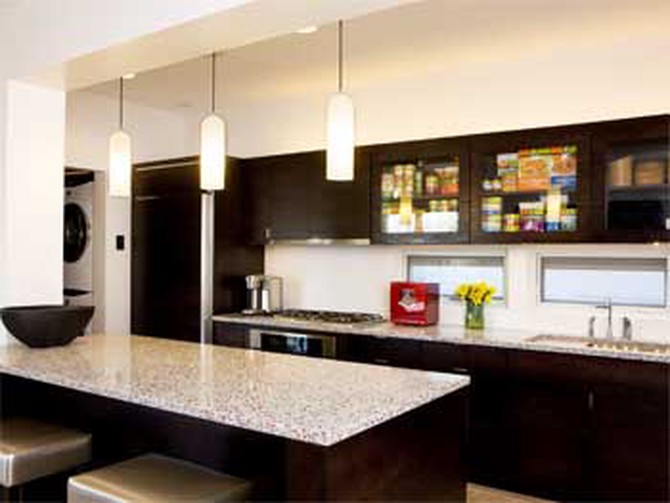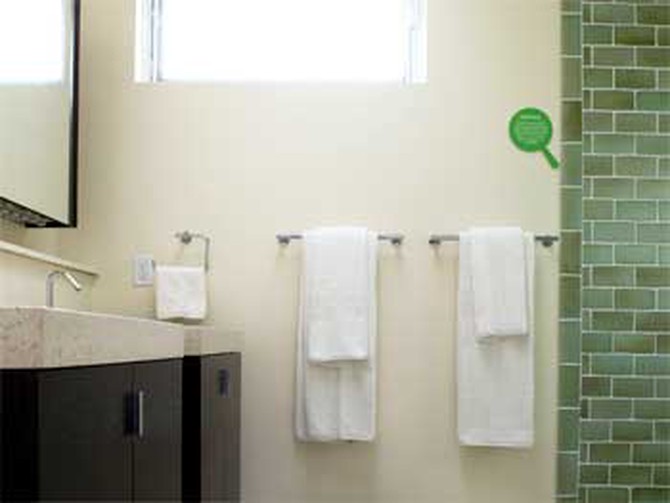Inside Chicago's Smart Home
By Erin E. White

Photo: JB Spector, Museum of Science and Industry
The Smart Home: Green + Wired
The three-story, 2,500-square-foot Smart Home, an exhibit on the campus of Chicago's Museum of Science and Industry, is the ultimate "green house." Anne Rashford, the museum's director of temporary exhibits, says the home was built to show people what a fully functioning, eco-friendly home can look like. "Everything works—it is not a prop house," she says. "You could take a shower, you can flush the toilets. All of the appliances work, and that has always been the mission of the museum—to have real artifacts."
The home was designed by architect Michelle Kaufmann to be material, energy and water efficient, as well as comfortable and stylish. Solar panels, a rainwater collection system and a wind turbine are just some of the outdoor furnishings that make this home eco-friendly. The landscape, designed by Chicago area Master Gardeners is organic and features plants native to the Chicago area. "Native plants don't need a lot of water—they are used to our Midwest environment and they thrive here," Rashford says.
The home was designed by architect Michelle Kaufmann to be material, energy and water efficient, as well as comfortable and stylish. Solar panels, a rainwater collection system and a wind turbine are just some of the outdoor furnishings that make this home eco-friendly. The landscape, designed by Chicago area Master Gardeners is organic and features plants native to the Chicago area. "Native plants don't need a lot of water—they are used to our Midwest environment and they thrive here," Rashford says.

Photo: JB Spector, Museum of Science and Industry
The Dining Room
The floor plan of the home is open and airy, with no walls between the dining room, kitchen and living room and ceilings that soar to the third level. The floor plan helps to heat and cool the home efficiently and gives the illusion of more space, Rashfrod says.
The dining room table is made out of steel, which Rashford says is one of the most recyclable materials on the planet. Chicago artist Ted Harris was so inspired by the table, Rashford says he created custom chandeliers made from recycled motorcycle parts to hang in the dining room. The chairs around the table are garden chairs from a resale shop that were painted black. The seats were reupholstered with material that looks like leather but is actually made from recycled soda bottles.
The dining room table is made out of steel, which Rashford says is one of the most recyclable materials on the planet. Chicago artist Ted Harris was so inspired by the table, Rashford says he created custom chandeliers made from recycled motorcycle parts to hang in the dining room. The chairs around the table are garden chairs from a resale shop that were painted black. The seats were reupholstered with material that looks like leather but is actually made from recycled soda bottles.

Photo: JB Spector, Museum of Science and Industry
The Kitchen
The Smart Home's kitchen features Energy Star appliances, and the countertops are made of cement and recycled glass from red stoplights. A small, red microwave on the countertop is compact and energy efficient, and the wood cabinets are sustainable. "The kitchen cabinets are all FSC [Forest Stewardship Council]-certified wood, so we know where the wood came from—it came from a [sustainably] managed forest," Rashford says.

Photo: JB Spector, Museum of Science and Industry
The Living Room
A movable, ethanol-burning fireplace separates the dining room from the living room, and all of the living room furniture is made with green materials. "All the fabrics in the house have a green story. They're either organic wool or organic cotton or some sort of recycled material," Rashford says.

Photo: JB Spector, Museum of Science and Industry
The Master Bedroom
Bamboo floors run throughout the Smart Home and match beautifully with the master bedroom's bed and nightstand, which are made from reclaimed wood.
On the wall above the nightstand is a small touch screen that is part of the Smart Home's state-of-the-art home automation system. You can control music and entertainment systems as well as heating and cooling throughout the home from the touch screen or remotely from your cell phone or computer. Those are just some of the Smart Home's technological capabilities. "We have real-time energy monitoring, so we know how much the energy the house is consuming and using, how much solar [power] we are producing and how much wind we are producing because we have a wind turbine on the site as well," Rashford says.
On the wall above the nightstand is a small touch screen that is part of the Smart Home's state-of-the-art home automation system. You can control music and entertainment systems as well as heating and cooling throughout the home from the touch screen or remotely from your cell phone or computer. Those are just some of the Smart Home's technological capabilities. "We have real-time energy monitoring, so we know how much the energy the house is consuming and using, how much solar [power] we are producing and how much wind we are producing because we have a wind turbine on the site as well," Rashford says.

Photo: JB Spector, Museum of Science and Industry
The Master Bath
The floors in the Smart Home's master bath are tiled with recycled marble, and the green tile in the shower area of the bathroom is made from recycled Chardonnay bottles. "The countertops are made from fly ash [a byproduct of coal production] but also recycled porcelain, so there are pieces of toilets, sinks and bathtubs in the countertops," Rashford says.

Photo: JB Spector, Museum of Science and Industry
A Green Roof
The Smart Home's roof is covered with modular trays in which drought-resistant succulents and wild onions have been planted. These plants don't have to be watered, and they provide year-round savings to home owners. "A green roof helps you extend the life of the roof because it actually protects from the elements, but it also keeps the home warm in winter and cool in summer," Rashford says. You can eat the wild onions too!
While the Smart House was built to showcase the latest in green technology and design, Rashford says the eco-design field is growing and evolving rapidly, so the house will continue getting yearly updates as long as it is open to make sure it stays on the cutting edge.
While the Smart House was built to showcase the latest in green technology and design, Rashford says the eco-design field is growing and evolving rapidly, so the house will continue getting yearly updates as long as it is open to make sure it stays on the cutting edge.
Keep Reading
Published 10/13/2009




